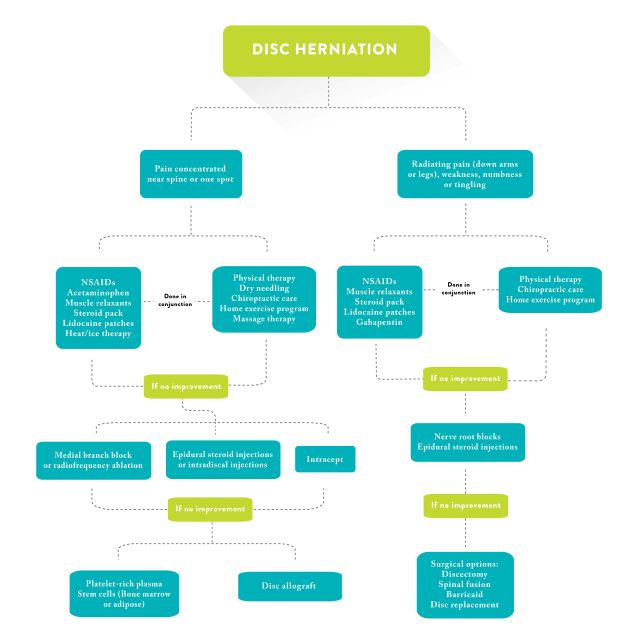The Disc Herniation Treatment Pathway

Millions of people live with chronic, even debilitating, back pain. Disc herniation is one of the most common reasons for back and neck pain. Fortunately, treatment options are available.
If you have pain that’s slowing you down, the first step is identifying whether or not a herniated disc is to blame. From there, your neurosurgeon or physiatrist will help you find relief by following the disc herniation treatment pathway. The goal is to find the most relief with the least invasive treatments.
Here is everything you need to know about disc herniation and the treatment pathways available to relieve neck and back pain.
What Is Disc Herniation?
Disc herniation, also known as a slipped or herniated disc, occurs when a spinal disc’s soft, jelly-like center pushes through a crack or tear in its tough outer layer. It can happen in any part of the spine but most commonly occurs in the lower back (lumbar region) or the neck (cervical region).
Disc Herniation Treatment Pathway

(Full-Size Disc Herniation Treatment Pathway)
The treatment for disc herniation will vary depending on the severity of symptoms and the location of the affected disc. It also depends on what the pain feels like. There are two main types of pain related to a herniated disc.
1. Axial Pain
Axial pain occurs right at the site of the affected disc. You’ll feel this pain in a single spot in your neck or back and may describe it as focused pain.
2. Radiating Pain, Weakness, Numbness, or Tingling
When the disc material and inflammation press on the nerves coming out of your spine, it can cause pain that radiates down your arms or legs. It can also cause your limbs to feel weak, numb, or tingly. These are all signs that the herniated disc is more severe and may require more intense treatments.
Treatment Pathway for Axial Pain
If you’re experiencing axial or focal pain without additional symptoms, your doctor will recommend conservative therapy first.
Conservative Therapy
For a mild herniated disc, pain may be relieved by using a combination of medications. Some are available over the counter, but your doctor may prescribe multiple types of medications so that you get the most significant pain relief with lower dosages of drugs and reduced side effects. Here are some of the medications you might take to resolve your neck or back pain.
- NSAIDs. Nonsteroidal anti-inflammatory drugs help reduce pain and inflammation. These include ibuprofen or naproxen as over-the-counter options or diclofenac and meloxicam as prescription options.
- Acetaminophen. Over-the-counter acetaminophen can provide pain relief and may be a better option for people who cannot tolerate NSAIDs.
- Muscle Relaxants. These medications can help relax muscles that are spasming due to the pain of the herniated disc.
- Steroid Pack. Short-term use of oral steroids can reduce inflammation, relieving pain.
- Lidocaine Patches. Topical lidocaine patches offer localized pain relief by numbing the affected area.
- Heat and Ice Therapy. Alternate heat and ice therapy is a useful and easily accessible at-home therapy.
The following modalities are essential in addressing the underlying problem. Your doctor may recommend these additional treatments in conjunction with pain medications.
- Physical Therapy. Therapy provides targeted exercises and stretches that strengthen the spine, reducing pressure on the affected disc.
- Dry Needling. Dry needling is an acupuncture technique that helps relax muscles and provide natural pain relief.
- Chiropractic Care. Chiropractic adjustments may help realign the spine. This should be done only after consultation with a neurosurgeon or physiatrist, as chiropractic care can cause damage if performed in the wrong situation.
- Home Exercise Program. A tailored exercise plan can aid recovery. Typically, your doctor or physical therapist will help you create a program you can do at home.
- Massage Therapy. Therapeutic massage can relax muscles and improve blood flow.
Interventional Therapies
If conservative therapies have not provided adequate pain relief or if you’re experiencing facet joint pain where the spinous process of two vertebrae meet, then your doctor may attempt the following interventional therapies.
- Medial Branch Block. With a medial branch block (MBB), your doctor will inject a numbing medication into the nerves responsible for facet joint pain.
- Radio Frequency Ablation. During radiofrequency ablation, your doctor will apply heat directly to your nerves, causing them to stop transmitting pain signals.
Vertebral bones have an area referred to as the endplate on each end of the bone. Within the endplate are vital nerves that cause pain when compressed. If you’re experiencing changes to your endplates in addition to a herniated disc, your doctor may recommend the Intracept procedure. Intracept is a minimally invasive treatment that destroys the basivertebral nerve in the endplate, preventing it from sending pain signals to the brain.
Interventional Therapy for Mild Disc Herniation
For situations where there is mild disc herniation but no other problems like facet joint pain or endplate changes, there are two treatment options that can be effective in addressing pain.
- Epidural Steroid Injections. Corticosteroids are potent anti-inflammatory medications. They can be injected directly into the spinal canal (known as an epidural) to reduce inflammation and relieve pain.
- Intradiscal Injections. Medications like steroids can be injected directly into the herniated disc to help control pain.
Treatment Pathway for Radiating Pain, Weakness, Numbness, or Tingling
Your doctor will initially recommend conservative therapies for radiating pain, weakness, numbness, or tingling. However, if you are experiencing radiating pain, weakness, numbness, or tingling, your doctor may adjust your pain management strategy since these are often signs of more advanced damage to the herniated disc.
Conservative Therapy
Your doctor may recommend one or more of the same treatments recommended for axial, except for acetaminophen, as it is typically not strong enough. NSAIDs, steroid packs, muscle relaxers, and lidocaine patches can all be helpful.
Additionally, gabapentin may be prescribed. This is a medication that can help relieve nerve-related pain.
In addition to medical therapy, physical therapy, and chiropractic care, your doctor may implement a customized home exercise program. However, dry needling and massage therapy are less effective for radiating pain, weakness, numbness, or tingling, so they are not recommended as often.
Interventional Therapies
Your doctor may consider more advanced interventional treatments when conservative therapies are ineffective at managing pain, such as:
- Nerve Root Blocks. This is when medications are injected into the nerves that are causing radiating pain to help calm them down.
- Epidural Steroid Injection. Similar to axial pain, epidural steroid injections can be effective in reducing radiating pain, numbness, and weakness.
Surgical Therapies
If conservative options and international therapies do not address the pain, surgery is typically the next option. Several effective surgical treatments are available for disc herniation.
- Discectomy. In this procedure, a portion of the damaged disc is removed so it no longer presses on nearby nerves.
Barricaid. A Barricaid is a polymer plug inserted into the hole left behind after a discectomy. If there is a large hole, there is a risk the disc can herniate. Barricaid plugs the hole to prevent that from happening. - Spinal Fusion. Spinal fusion is a procedure that stabilizes the spine to eliminate movements that cause pain. The herniated disc is removed, then bone grafts are placed between the two vertebrae. The bone grafts heal the two bones together, creating stability.
- Disc Replacement. The damaged disc is removed and replaced with an artificial one.
No One Should Suffer With a Herniated Disc
Millions of people suffer from back pain and herniated discs. Even mild disc herniation can interrupt your life. But you don’t need to endure this type of pain and disruption any longer. By partnering with an expert neurosurgeon or physiatrist, you can start on the path to living a pain-free life again.
Don’t delay — schedule an appointment today!

